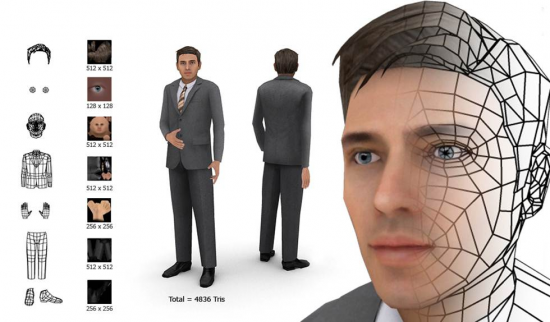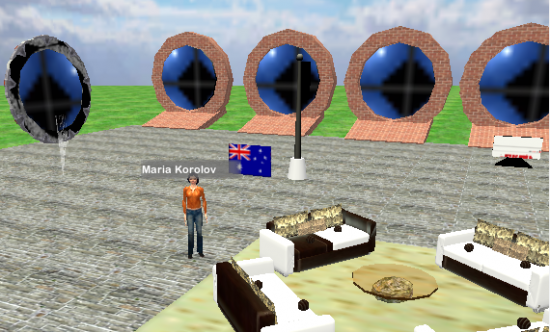The recently-released OpenAvatar kit for open source avatars could help enterprise users of virtual worlds reduce vendor lock-in and, eventually, lead to significant improvements in the appearance of avatars, VastPark CEO Bruce Joy told Hypergrid Business.
VastPark is an Australian immersive environment vendor that has both commercial and open source versions of its virtual environment software.
The OpenAvatar kit is designed to add a level of abstraction between the virtual environment server and the avatar itself, and can be adopted by any virtual environment that uses mesh avatars.

Portable avatars

The original idea was that users could create a single avatar and use them in platform from different vendors, like SAIC’s Olive and Teleplace, said Lori Kavle, president of VastPark US.
That was the premise behind the USDA’s virtual government plan, she said, where VastPark was one of the chosen vendors.
“But everyone was so busy about working on their own platform, that the forward movement on having one avatar and interoperable systems didn’t happen,” she said. “So we took that on as a company to make that happen.”
Now, any vendor that wants to can adopt the OpenAvatar system for its avatars, instead of developing and maintaining its own proprietary avatar creation software.
“We’ve been impressed by the number of organizations interested in looking at it,” said Joy. However, no vendors have formally adopted OpenAvatar as of yet.
Once they do, companies will be able to move employee avatars from one platform to another when they switch virtual environment vendors, or if they use different platforms for different projects.
Looking good, avatar!
Existing avatar systems are hard-coded into their respective virtual world platforms. Second Life has one set of possible avatars, created using a slider system, and dressed using clothing layers. Teleplace uses another system, with mesh avatars of a certain polygon count, and a preset number of avatar choices. VenueGen uses yet another system.
Any improvements to the avatars must be reflected in server and viewer software updates.
OpenAvatar adds a layer of abstraction between the virtual environment software and the avatar itself, making it easier to improve the avatar without rewriting the code for the rest of the system. Or different viewers could show different versions of the same avatar, depending on system speed, graphics capability and bandwidth.

“We could be generating Unity avatars to run on the Unity client for VastPark and avatars that suit the WebGL environment automatically, with no extra work for the users,” Joy said.
And it’s not just about increasing the number of polygons that an avatar mesh is made of, he added.
“Mesh is the future for Second Life and OpenSim that they’ve been wanting to get to, but what we’re seeing in the games industry is more and more procedurally-generated content,” he said.
Say, for example, someone’s avatar is a round beach ball. If you use four triangles to make it, it will look like a pyramid. The more triangles you use, the smoother it will look — except if you look closely, you will still see the angles.
A procedurally-defined avatar will use the language of mathematics to basically say “this is a sphere.” Then it’s up to the viewer software to decide how to draw it — using fewer triangles on a mobile device, or when the avatar is viewed from faraway, and more triangles when it’s seen up close.
Fonts work the same way. In the old days, fonts were hard-coded. If you made the text bigger then the letters started looking jagged and pixellated. Today’s fonts are smooth — you can scale them up and down and they still look good.
“We could ultimately be generating extremely life-life avatars using that kind of approach and actually achieve it with very small bandwidth,” he said.
The same technique can be used for other content as well, he added, such as grass or textures. Users will be able to zoom in infinitely close and still see realistic detail.
No virtual closet
One disadvantage to the OpenAvatar platform is that there’s no provision for a virtual inventory as it exists in Second Life and OpenSim. Instead, clothing is baked right into the avatars.
To change outfits, a user would need to go back to the avatar management tool and choose from the built-in clothing options to generate a new avatar, Joy said.
In the future, however, OpenAvatar might be part of a bigger system where there is also a separate specification for inventories, he added.
No prim avatars
OpenAvatar does not support Second Life and OpenSim-style avatars either.
“We would love there to be a virtual world standard for primitives,” said Joy. “We have prims in our system, but they’re our prims, based on 3D Studio Max, in fact.”
Joy said that his main concern is that the prims that Second Life uses are proprietary to Second Life, and other companies that adopt them may be stepping on Linden Lab’s intellectual property rights.
Chris Collins, founder and CEO of Tipodean Technologies, maker of a Web-based viewer for OpenSim and Second Life, said he’s never heard of any copyright issues surrounding Second Life avatars. Collins was previously general manager of the enterprise division at Linden Lab.

And some of the technology has officially been released as open source, he told Hypergrid Business.
“The viewer is GPL,” he said, referring to an open source license of Second Life’s official viewer and its third party derivatives.
Meanwhile, the other commercial implementation of a Web-based viewer for OpenSim, 3Di Inc.‘s Rei viewer, avoids the issue altogether by only using their own, Irrlicht-mesh-based avatars.
The third-party viewers all use Linden Lab’s copyrighted meshes, 3Di senior engineer Dezso Zoltan told Hypergrid Business in an earlier interview. “You might or might not be able to use [them] for commercial purposes outside Second Life,” he said. “There’s a lot of ambiguity about those copyrights.”
OpenSim itself doesn’t have its own avatars, he added — all the heavy lifting is done in the viewers.
“The avatar inside OpenSim is just a capsule shape,” he said. “The way avatars work is that there is a fairly large set of parameters that control how some mesh is being deformed by some algorithm. All OpenSim does is sotre those parameters — it doesn’t really have an avatar engine at all.”
Linden Lab did not respond to our requests for comment.

OpenSim core developer Crista Lopes, inventor of the hypergrid and professor of informatics at the University of California, Irvine said she’s never heard of there being an issue around avatar copyrights.
“Linden Labs did not invent prims,” added OpenSim core developer Melanie Thielker, who is also the CEO of OpenSim hosting company 3D Hosting and founder of the Avination grid. “Primitive building blocks have been around for ages, only the way to describe them as data is unique to Linden Labs.”
But that description is not significant enough to warrant a patent, she added.
“Linden retains the copyright for the code that renders them, but has licensed that to the community under the GPL, which is irrevocable,” she said. “Therefore any company that uses their code in a GPL viewer is in the clear.”

If a company wants to use the same exact code in a non-GPL licensed viewer — for a proprietary, commercial viewer, for example — they would have to get a license from Linden Lab, she added.
That doesn’t mean that someone can’t write original, new code that has the same functionality, Thielker added.
“Copyright applies to the verbatim reproduction of text rather than to abstract concepts like algorithms,” she said. ” The test for this theory, however, is still outstanding because the GPL has not yet been formally challenged in a court of law.”
- OSgrid back online after extended maintenance - April 16, 2025
- Analysts predict drop in headset sales this year - March 25, 2025
- OSgrid enters immediate long-term maintenance - March 5, 2025
